
By Alissa Westervelt
Rocinha and Environmental Degradation
Rocinha is the largest favela in the city of Rio de Janeiro, Brazil. It has an estimated 100,000-150,000 people residing in an area measuring 2.23 square kilometers, which translates to a population density of 44,800-67,300 people per square kilometer (UN Habitat, 2007). Rocinha is located in the south of the city, about one kilometer away from the beach. It is surrounded by some of the wealthiest neighborhoods in the city, Ipanema and Leblon to the east and Gavea Golf and Country Club to the west. The neighborhood is located on a steep mountain slope with the Tijuca National Park bordering it to the north ( UN Habitat, 2007). Most of the buildings are made of concrete or brick and many are several stories high.
The neighborhood has access to basic plumbing, electricity, and sanitation. The proximity to wealthy neighborhoods means that some residents are able to work outside of the favela, but most work informally in the community (Carter, 2004). The Brazilian government estimates that there are about 5,000 locally owned businesses in the area serving the needs of the residents, including TV ROC, a local television station (Strother, 2010). Despite Rocinha’s level of development, there are no hospitals in the community and very little access to healthcare. On average the citizens have only 4.1 years of formal schooling and a consistently low score on the Human Development Index when compared to other favelas within Rio de Janeiro (Mundo Real, n.d.).
While it is considered one of the wealthiest favelas in Rio, poorer resident are moving further north in an area known as Roupa Suja, building on nearly vertical rock formations while cutting down trees in the Tijuca forest to make additional space (Carter, 2004). This puts the poorest residents exposed to landslides caused by increased deforestation. Rio’s municipal government and individual residents have built aqueducts to manage heavy rainfall and reduce the risk of mudslides but the population grows faster than infrastructure can keep up (Carter 2004). In 2009 Rocinha worked with the municipal government to plan a barrier between the favela and the forest that could be used as a community space for residents while protecting the ecosystem (Boscov-Ellen, 2009). This project is unimplemented as the government’s focus shifted to security concerns. The newest residents are at a greater risk as they are less able to build with reliable material and must live farther away from services (Boscov-Ellen, 2009).
Many of the new residents are fleeing violence and economic insecurity in smaller, more distant favelas. The municipal government, with the help of UN Habitat, is putting increased emphasis on security for the high-profile favelas like Rocinha as Brazil prepares for the 2014 World Cup and 2016 Olympics (Romero, 2011). It will be important for some of this focus to shift to the smaller, less central favelas. Increasing security and services in less affluent favelas can help slow migration to Rocinha. Additionally, educational campaigns explaining the real health and safety risks associated with deforestation would be a start to stemming some of the most dangerous development.
This article is a product of Professor Shagun Mehrotra’s Global Urban Environmental Policy class. Views expressed are entirely those of the individual author.
References
Boscov-Ellen, L. (2009). Out of site, out of mind: Rio’s slum solution: Council on Hemispheric Affairs: Retrieved February 5, 2012 from coha.org
Carter, J. (2004). Residents of Rio’s favelas face diverse risks: World Watch Institute: Retrieved February 6, 2012 from worldwatch.org
Google. (2012). Google Earth (Version 6.0.3.2197) [Software]. Available from http://www.earth.google.com
Mundo Real. About Rocinha: retrieved February 4, 2012 from 1mundoreal.org
Romero, S. (2011, November 13). Rio slum is ‘pacified’ in advance of games. New York Times. Retrieved from nytimes.com
UN Habitat. (2007). Enhancing urban safety: global report of human settlements, Vol. 3. U.S.: United Nations Human Settlement Program: Retrieved February 5, 2012 from unhabitat.org
Strother, J. (2010). Bringing business to Brazil’s slums [Radio series episode]. In The World. Public Radio International. Retrieved from PRI.org